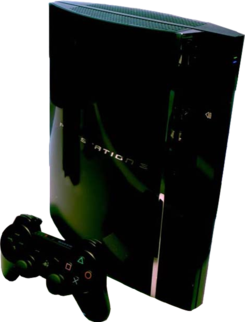PlayStation 3
| PlayStation 3 | ||
|---|---|---|

| ||
| Original ("fat") PS3 | ||
| Release Date | 2006/2007 | |
| Developer | Sony | |
| Game Chronology: | ||
| PlayStation 2 | PlayStation 3 | PlayStation 4 |
The PlayStation 3 was Sony Computer Entertainment's third video game console. It is the successor to the PlayStation and PlayStation 2. The PlayStation 3 competed mainly with Microsoft's Xbox 360 and Nintendo Wii as part of the seventh generation of Video Game Consoles, although the Wii has a completely different range of games and is aimed at a completely different audience.
Contents
Release
The console was released on November 11, 2006, in Japan, on November 17, 2006, in the United States, Canada, Mexico, Hong Kong and Taiwan, on March 7, 2007 in Singapore, on March 22, 2007 in the Middle East, and March 23, 2007 in Europe and Australia.
The console was officially discontinued in Japan in 2017. Over 86 mio units have been sold so far.
Technical
The PS3 contained an IBM Cell Processor as the CPU and a Nvidia GPU. The CPU contains a PowerPC core and 8 Synergistic Processing Elements (SPEs) (6 of which are available to games) and has access to 256MB of XDR (Rambus) RAM. The GPU has an additional 256MB of DDR3 memory.
Save games are stored on the internal hard disc (that can be swapped for any SATA disk), games are sold on BluRay disks. Early models featured a 4 in 1 card reader. USB mass storage can be used to copy and backup most save games, most third party USB HID devices (such as controllers, keyboards, and mice) are supported as well.
The PS3 connects to the internet (and the PlayStation Network) using a gigabit Ethernet connection or 802.11g Wifi.
All PS3s are compatible to old PlayStation games by use of emulation, but only the first generation (never sold in Europe) are compatible with PlayStation 2 games.
Models
Original ("fat") Models
Initially the PS3 was release in a black reflective case including a card reader and either a 20GB or a 60GB hard disk. There are four USB 2.0 ports to connect accessories to.
Some of these models are compatible with PS2 games in addition to the PS compatibility.
The first models are known for hardware problems such as the Yellow Light of Death (YLoD), a problem caused by overheating, making the lead-free solder of either the graphics chip or the CPU brittle. This was resolved in later models.
Slim
The first Slim versions of the PS3 were released in 2008. They featured a 120GB hard disk drive, later on there were versions with 160, 250, or 320GB hard disks, and some special editions with 500GB disks.
All these models lack the card reader and only have two USB ports. They are only compatible to PS games, not PS2 games.
Power consumption has been radically decreased in these newer versions due to advancements in computer chip design.
Super Slim
Since 2012 the only versions available are the Super Slim models. These are still smaller than the Slim models and feature a 250 or 500GB hard disk, or a 12GB flash drive for the low cost models. In the last model produced Sony moved to 500GB disks completely. Power consumption as been reduced even further.
Tomb Raider on PS3
- Tomb Raider Underworld
- Lara Croft and the Guardian of Light
- The Tomb Raider Trilogy featuring HD remakes of the first two Crystal Dynamics titles, and the original version of Tomb Raider Underworld
The PlayStation 2 version of Tomb Raider: The Angel of Darkness can be run on a system that supports backwards compatibility. The PlayStation versions of the Classic games can be run on any PS3 model, either from the original disks or after download from the PlayStation Store.
Trophies
- Main article: Trophies
The PlayStation 3, just like the Xbox 360 (see Achievements), features a special reward system where the player is awarded so-called Trophy for achieving certain goals, like finishing a Level, beating a Time Trial or collecting a certain number of Secrets. Trophies were introduced in 2008 and made compulsory for all new games in 2009.
All newer Crystal Dynamics (LAU and the Reboot) of Tomb Raider support trophies on the PS3.